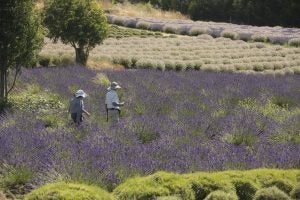A new study led by Penn State researchers finds that the availability and adoption of high-speed broadband appear to boost the number of farms offering agritourism activities. The researchers say their findings bolster the argument for expanding broadband availability in support of farm operators who want to benefit from the growing consumer interest in on-farm experiences.
“Agritourism operations are consumer-facing businesses that offer activities to farm or ranch visitors, such as farm stands, pumpkin patches, corn mazes, hayrides, and farm stays. They need to attract visitors, and most of their visitors find them online,” said Claudia Schmidt, assistant professor of marketing and local/regional food systems in Penn State’s College of Agricultural Sciences, who led the research. “Ours is the first study to examine the relationship between high-speed internet and agritourism specifically, demonstrating a clear relationship.”
In the study, published in the Journal of the Agricultural and Applied Economics Association, the researchers used several data sources — including the 2017 Census of Agriculture and the Federal Communication Commission’s fixed broadband deployment data — to conduct a nationwide, county-level statistical analysis of the relationship between a county’s average adopted broadband speed in 2012 and the number of agritourism businesses in that county five years later, while controlling for other relevant factors.

According to co-author Luyi Han, a postdoctoral researcher at the Northeast Regional Center for Rural Development based at Penn State, they included the five-year lag due to data limitations.
“Once high-speed broadband becomes available in an area, it takes time for its widespread adoption and for that adoption to translate into business expansion,” Han said. “For that reason, using agritourism data from the same year as our broadband data in our analysis could be misleading. Since our broadband data is from 2012, we used the next available Census of Agriculture for our agritourism data, which was 2017.”
They found that, on average, U.S. counties that adopted broadband speeds one megabit per second above the national average in 2012 had about 5 percent more agritourism operations in 2017 than counties that stayed at or below the national average speed. The researchers also conducted a secondary analysis to examine the effects of this relationship across the rural-urban continuum and found it to be more than twice as strong in urban counties with a population of at least 250,000. In rural counties, the relationship was not statistically significant.
Schmidt surmised that this rural-urban difference could be attributed to overall differences in tourism infrastructure, or it might speak to issues of digital equity.
“Many rural areas lack essential services like restaurants and lodging, and as a result, farms may struggle to attract visitors to their operations,” she said. “Similarly, even in rural places where fast internet speeds are available, educational services that entrepreneurs can access to learn how to leverage fast internet for their businesses may not be available. That suggests a real opportunity for land-grant universities and agricultural service providers to help expand agritourism by offering targeted internet trainings.”
She added that with the newest Census of Agriculture data released just earlier this year, they plan to examine this trend over a longer period of time in a future study.


